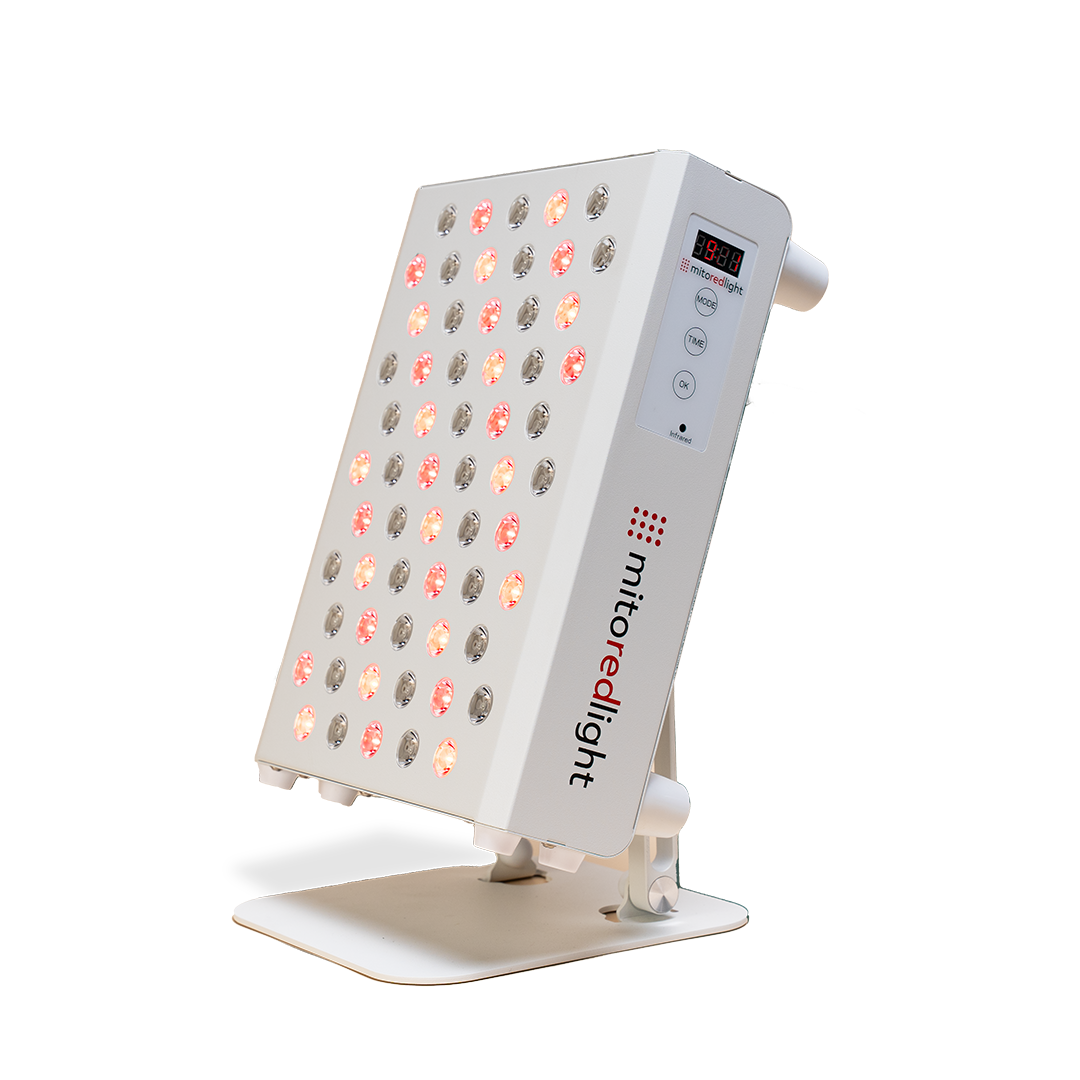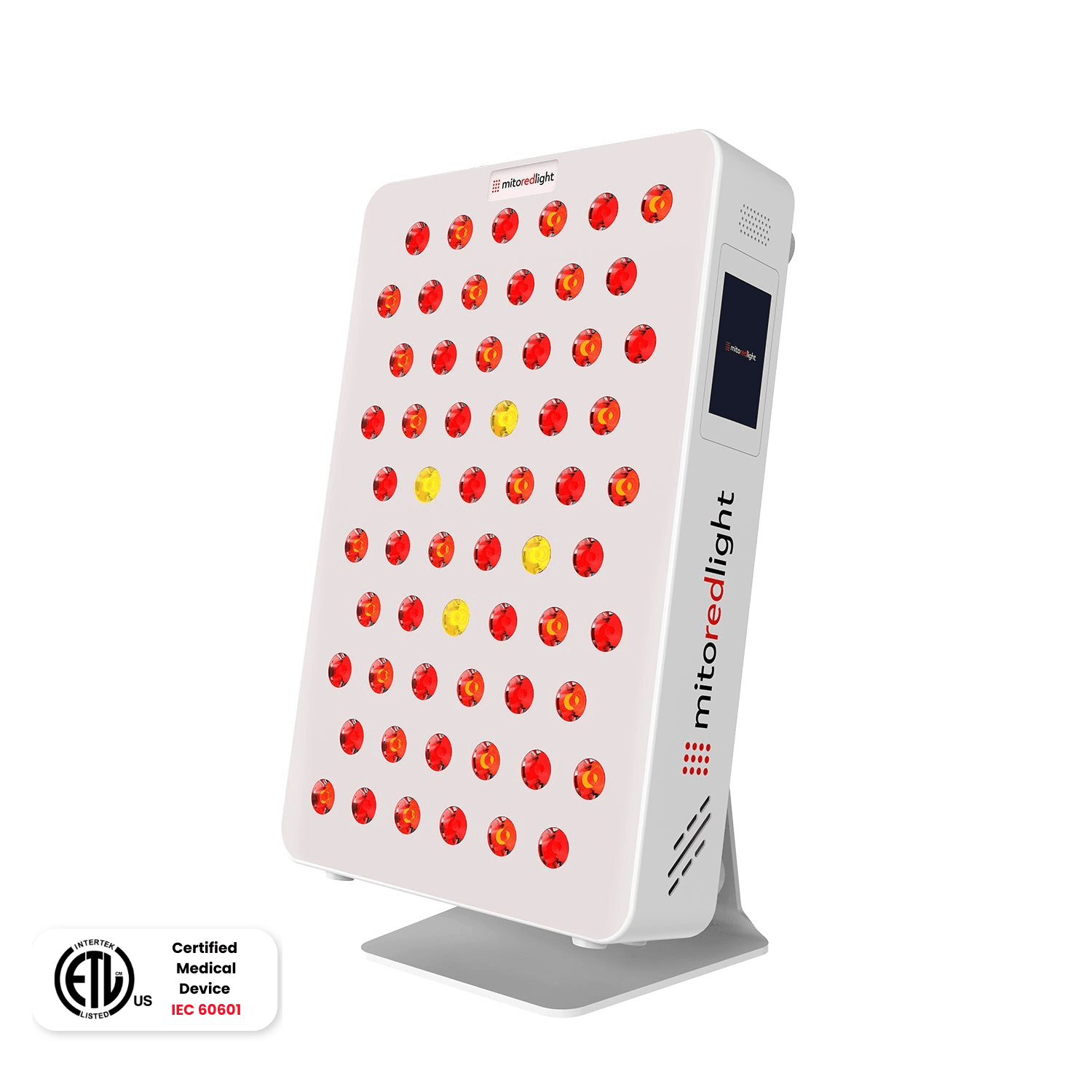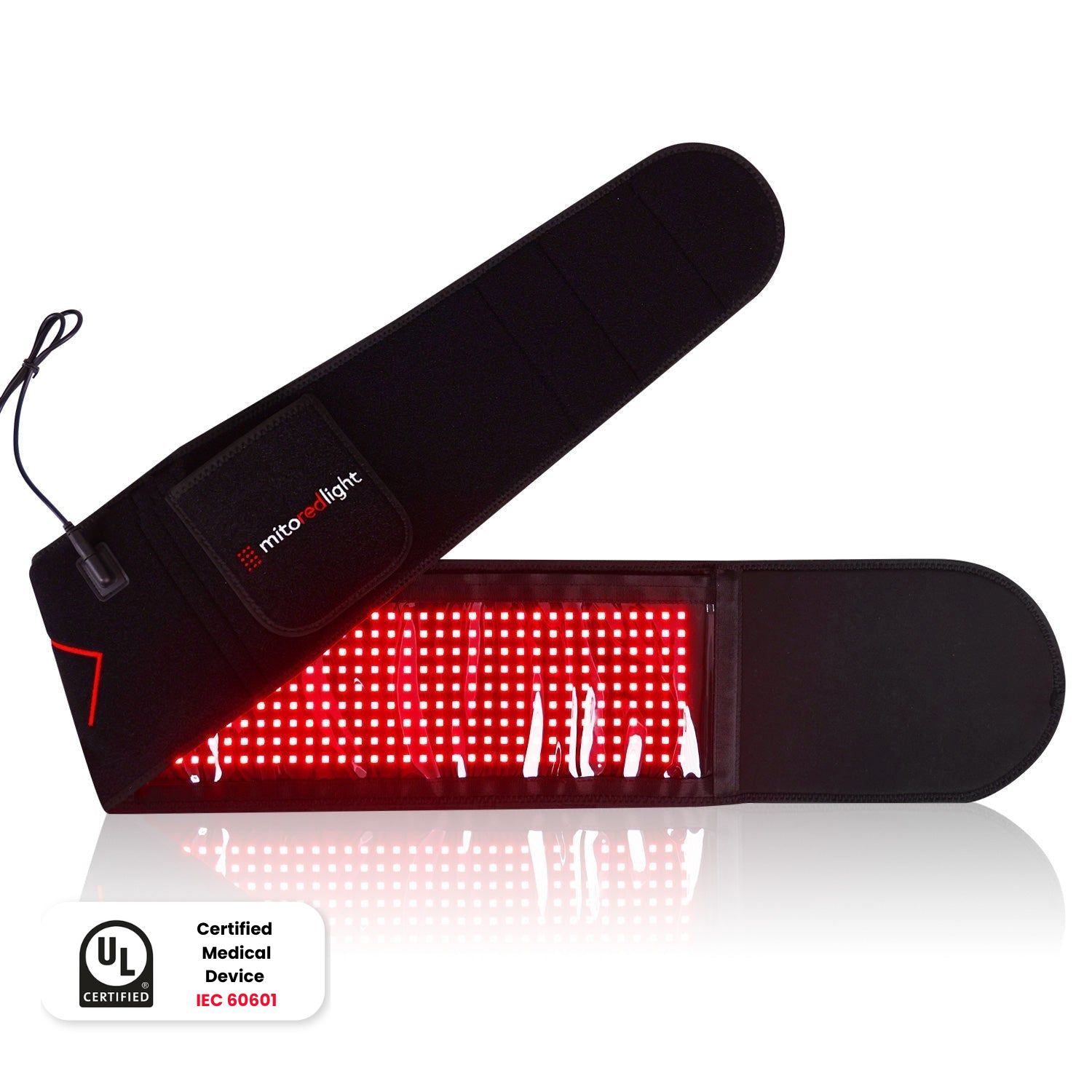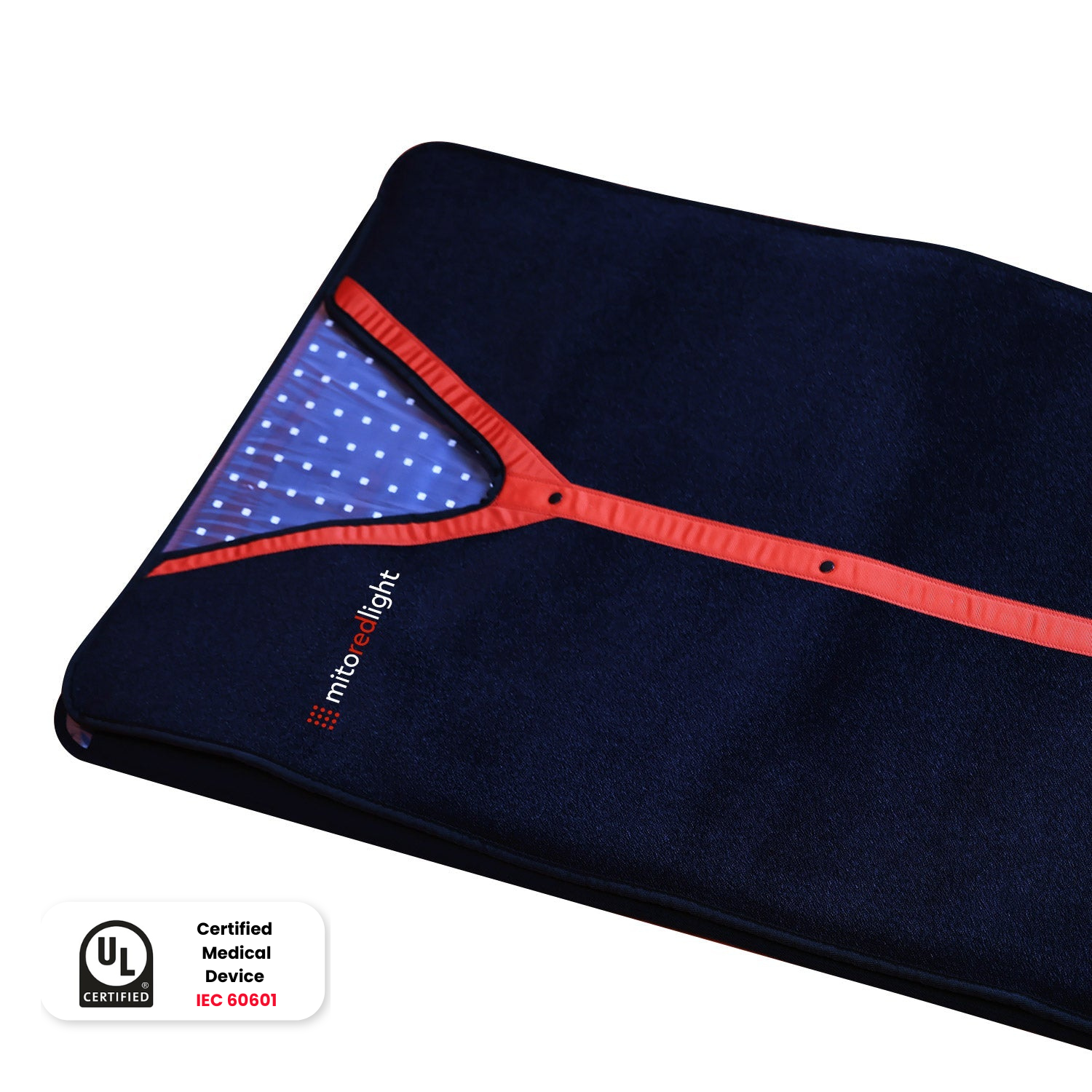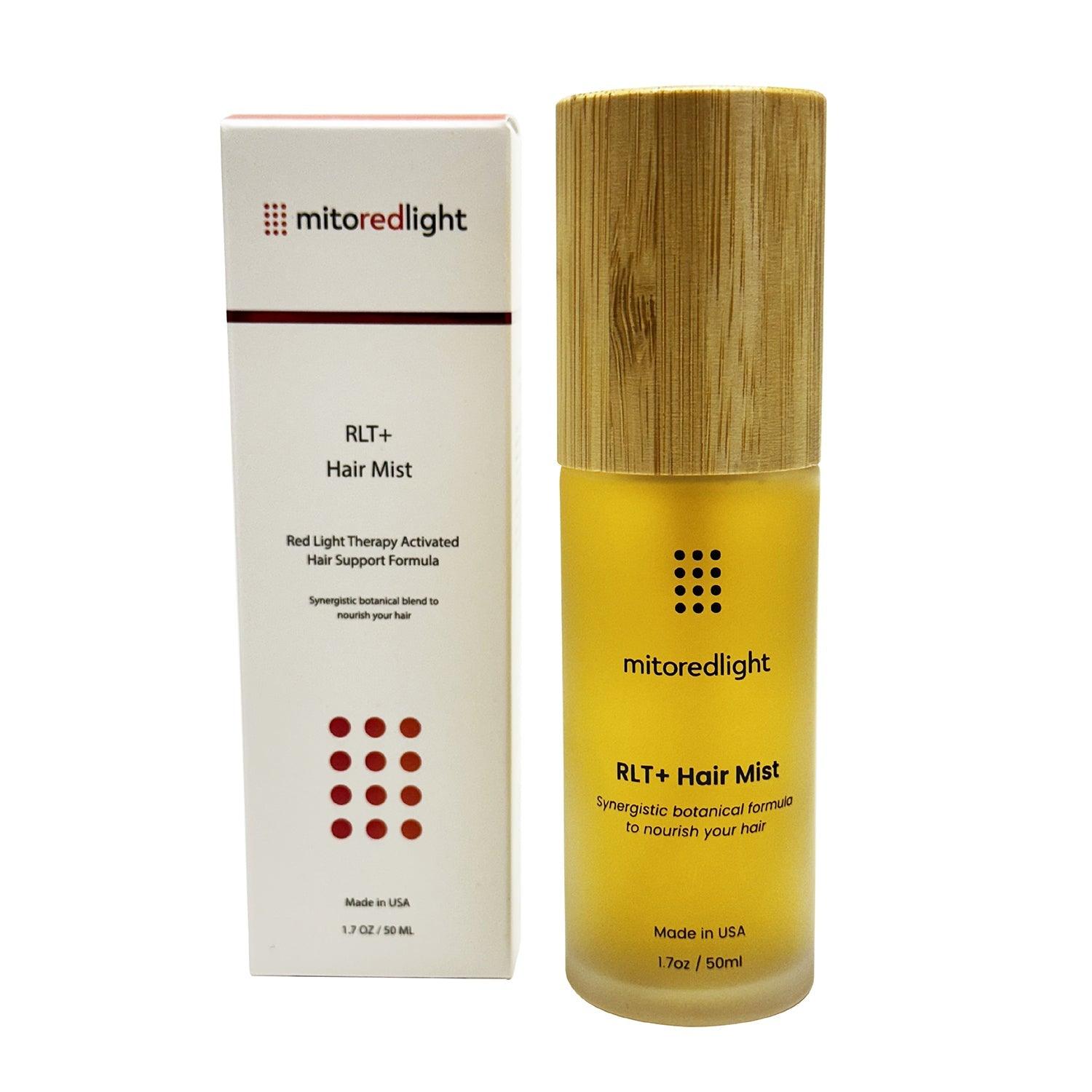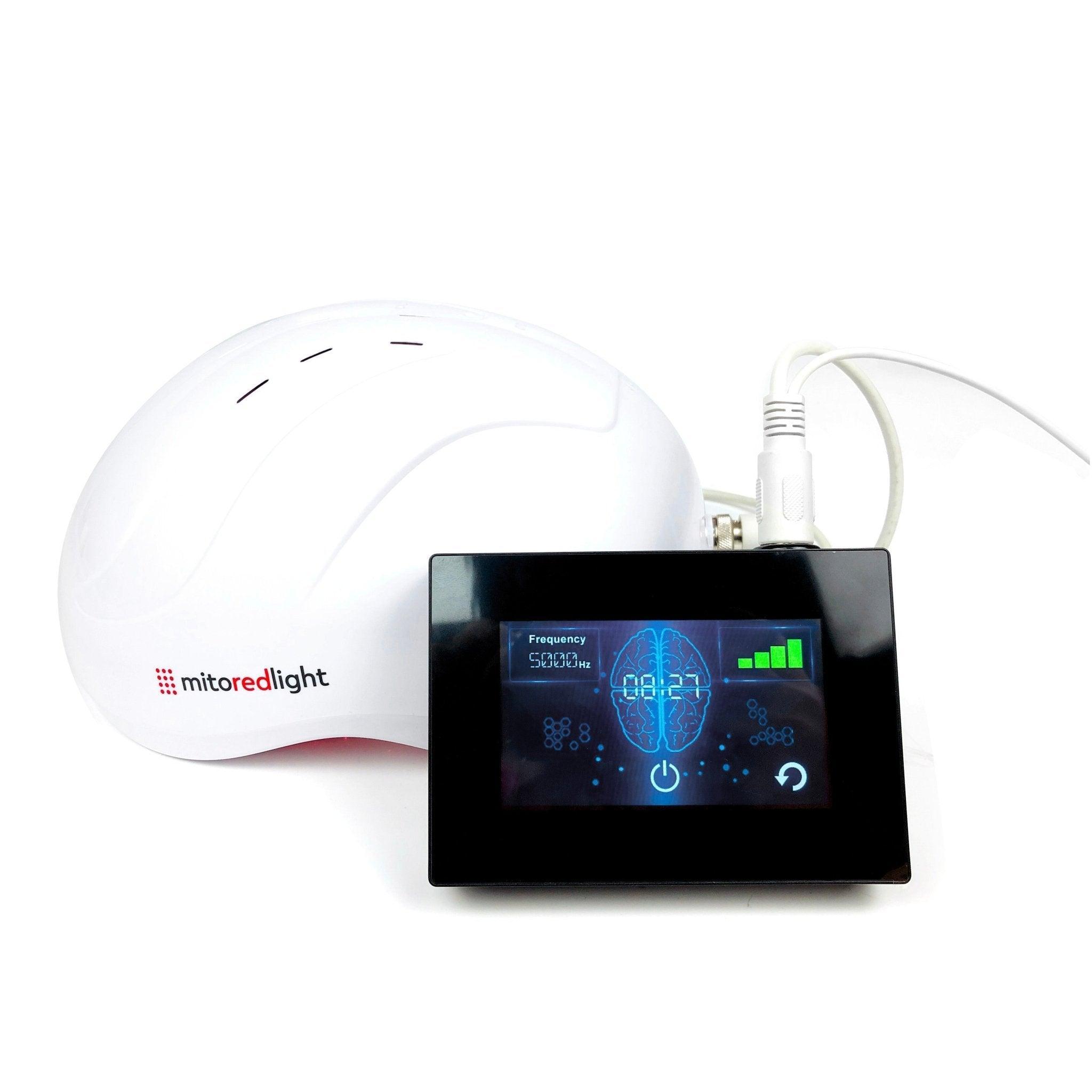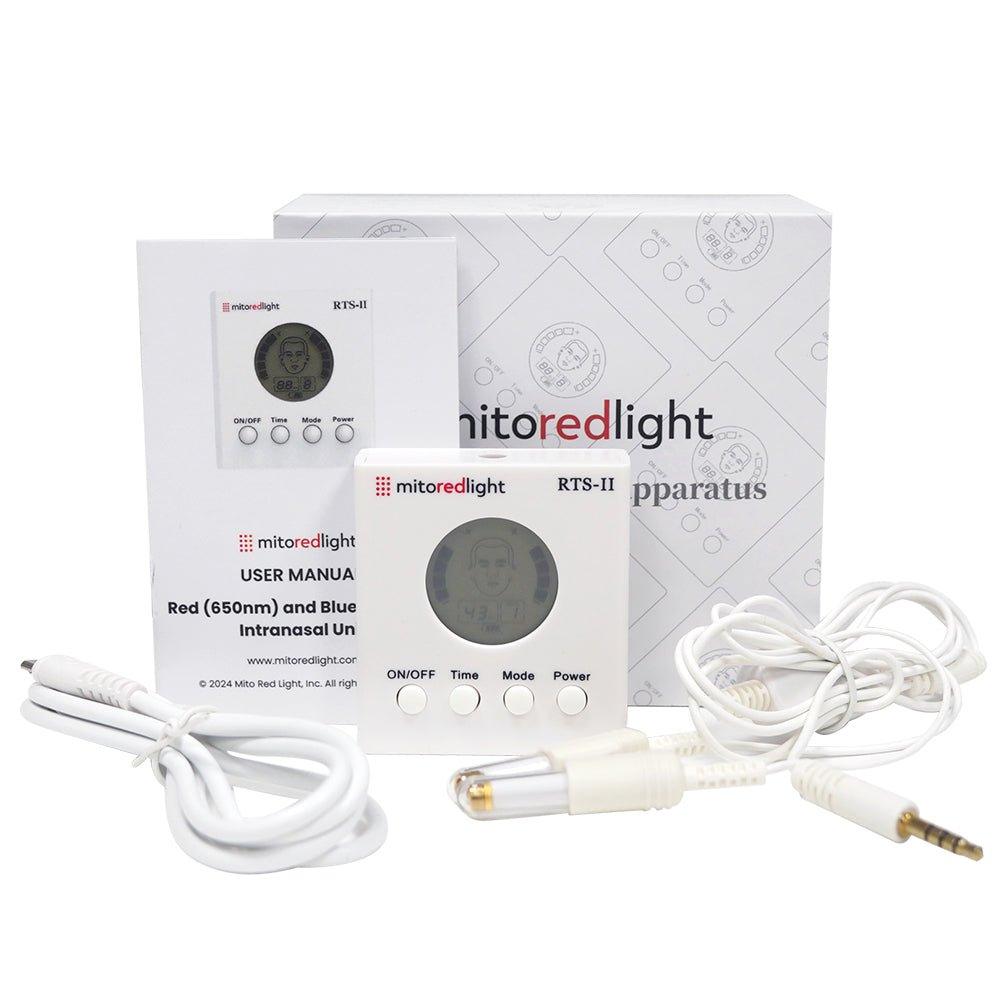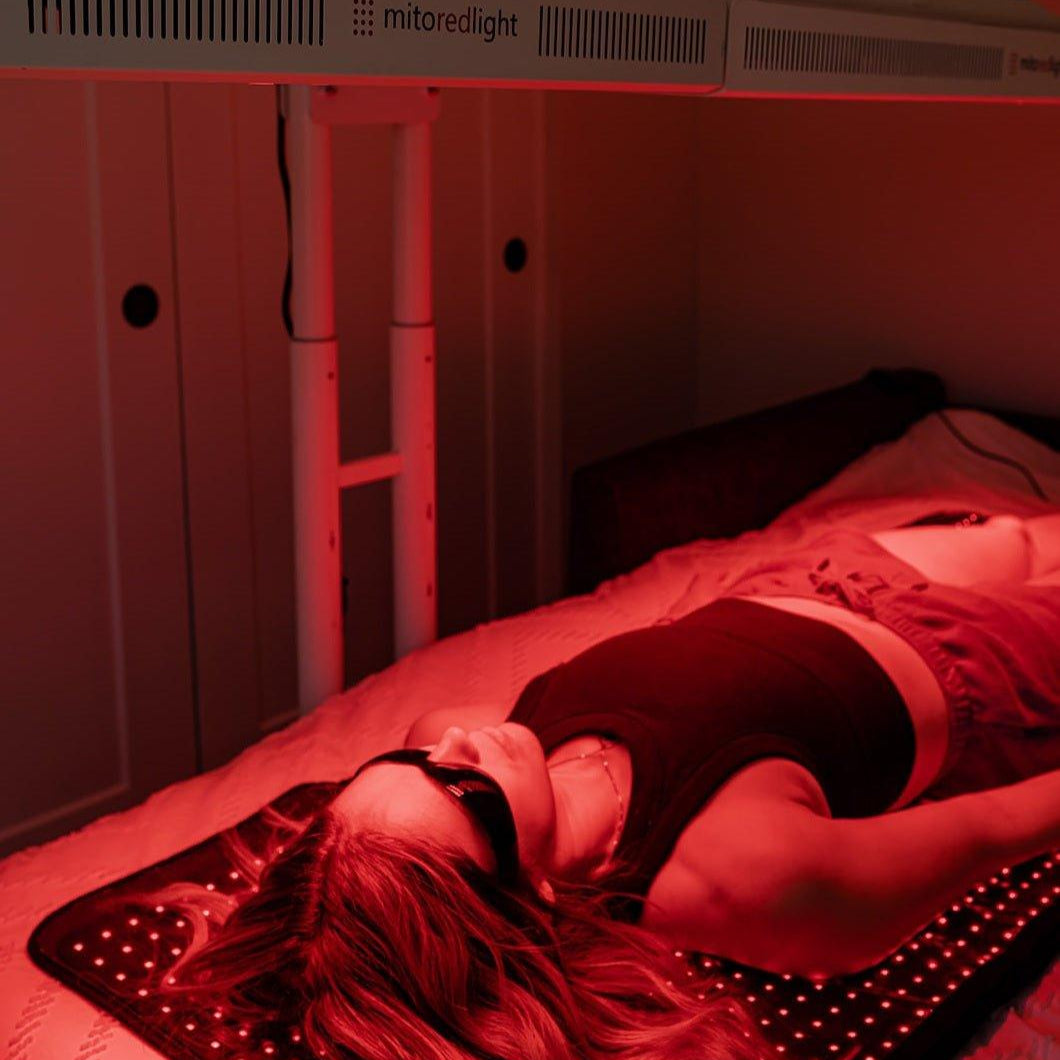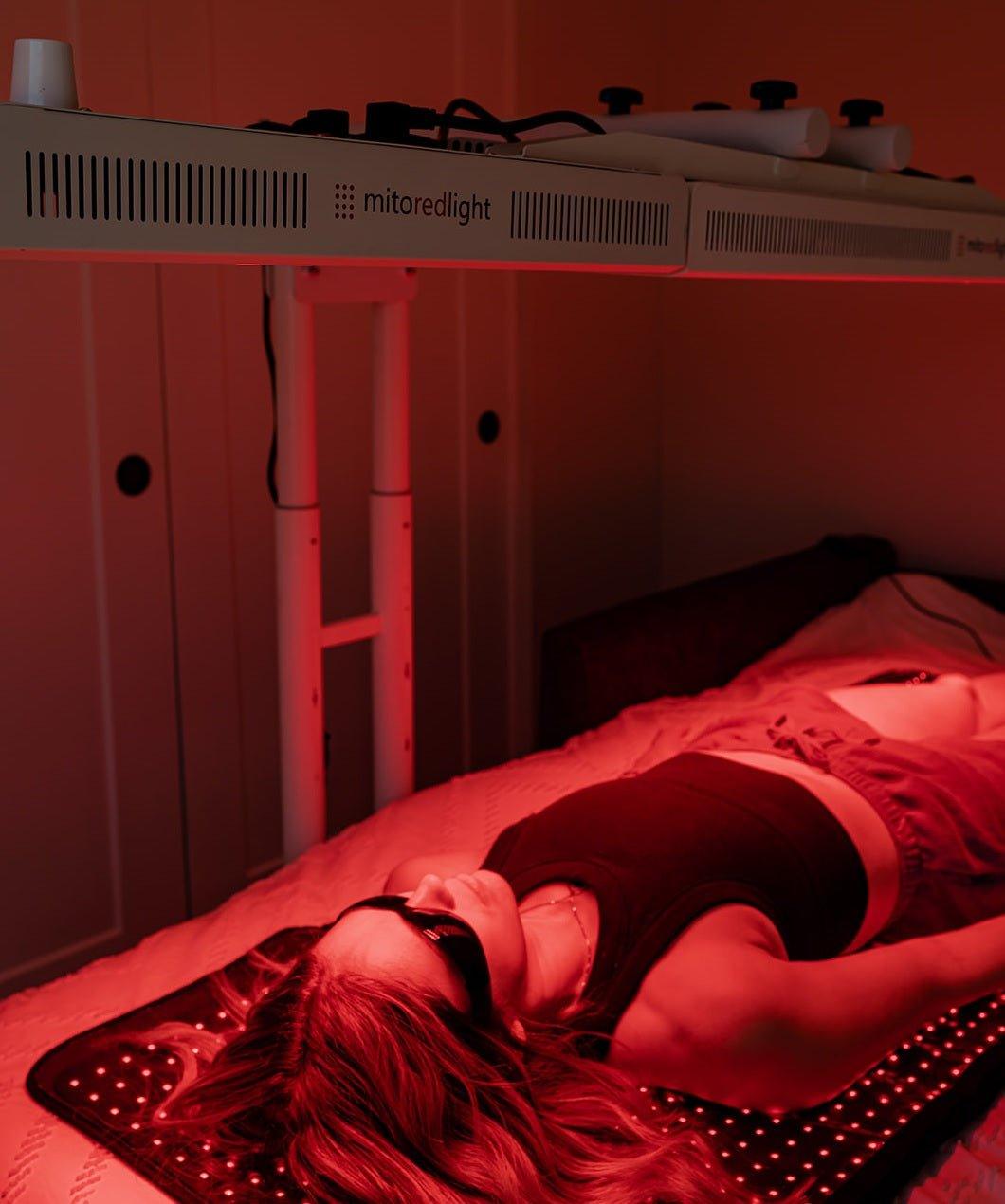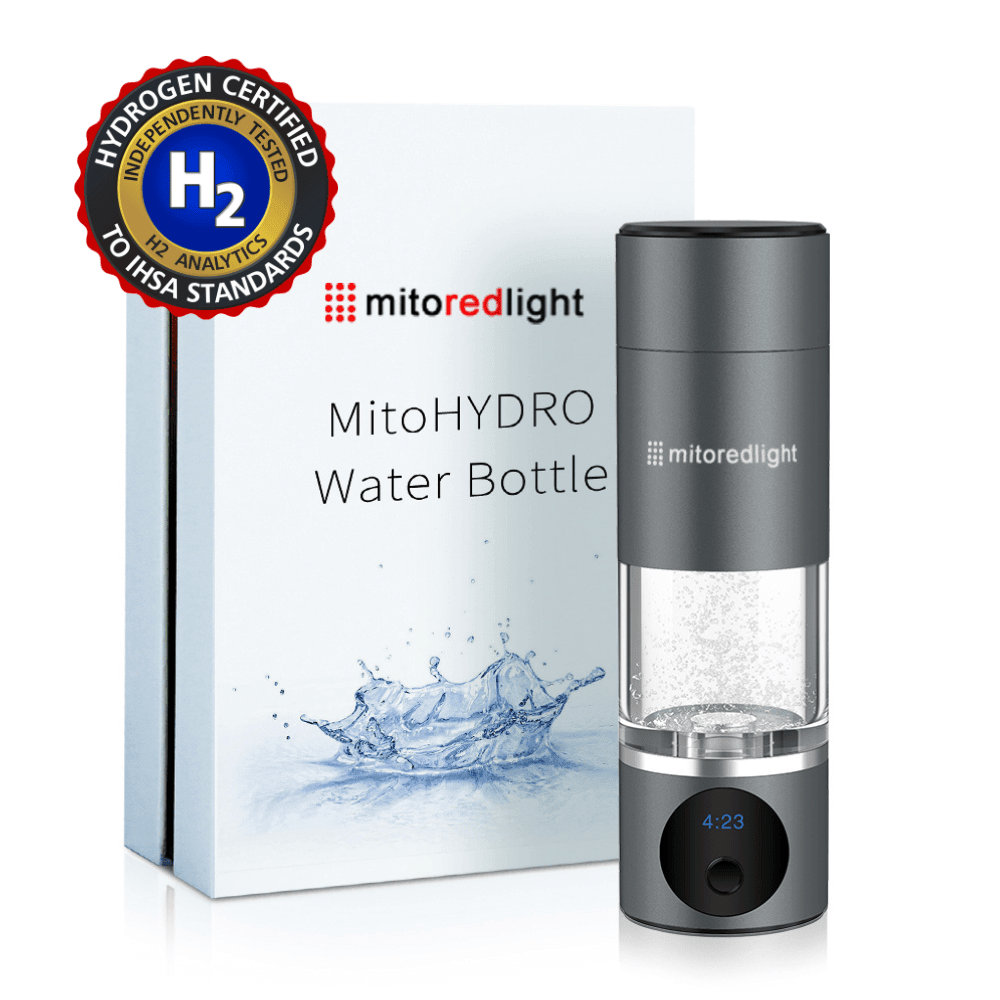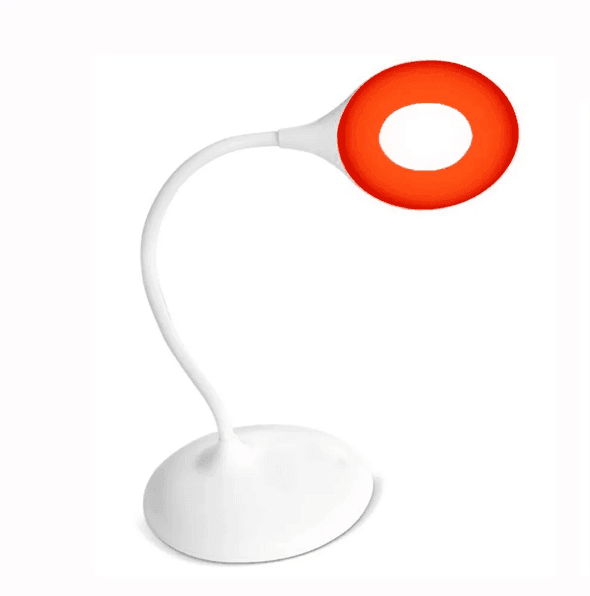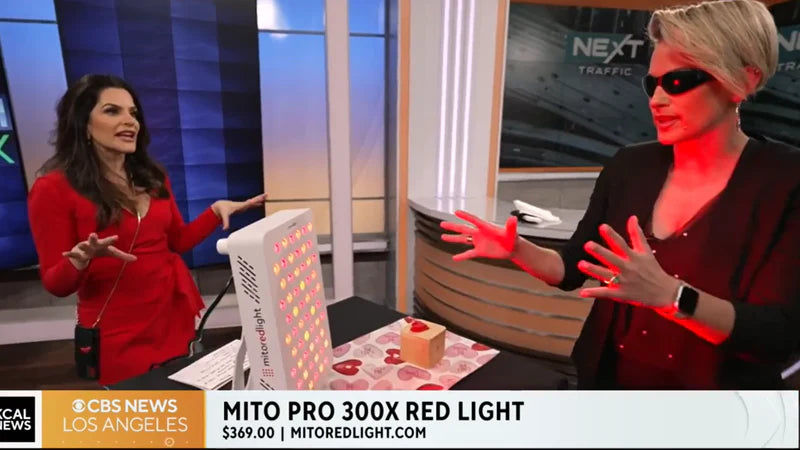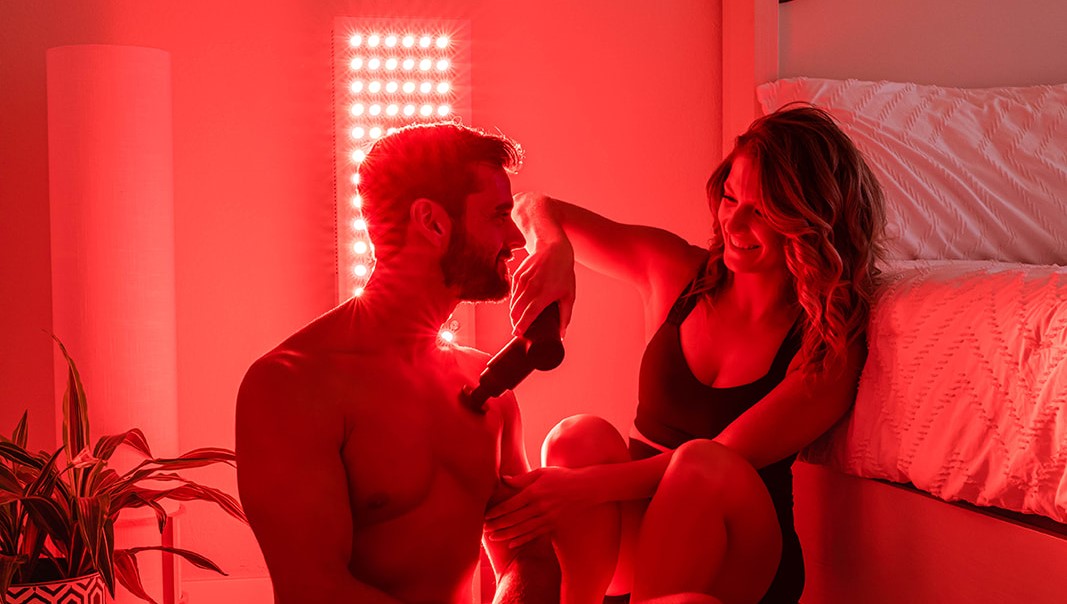Biohackers chase data that proves your body can do more when your cells have the right fuel, and that’s exactly where red and near-infrared light fit in.
Red light therapy (RLT) uses specific wavelengths, typically red (630-660 nm) and near-infrared (810-880 nm), to support the mitochondria in producing ATP. More efficient energy production can lend itself to better cellular performance across the board.
In this guide from Mito Red Light, we’re breaking down 10 red light therapy tools biohackers trust, built with precision specs, credible research, and safety certifications.
1. Mito Red Light MitoPro 1500X Panel
When biohackers talk about “serious hardware,” this is usually what they mean. The MitoPRO 1500X sits at the top of our lineup for a reason: it was engineered for people who care about data, precision, and measurable results, not just bright lights on a wall.
The MitoPro 1500X uses our patented ESPEO™ and TriChip™ multi-wavelength LED design, delivering both red (630-660 nm) and near-infrared (810-880 nm) light simultaneously. That range targets the mitochondria, supporting ATP production and cellular performance while helping manage pain and inflammation.
The TriChip™ layout ensures even energy distribution across every inch of the panel, preventing “hot spots” or uneven output, an upgrade experienced users notice immediately.
Technically speaking, this panel delivers irradiance levels competitive with clinical setups while staying IEC 60601-certified for safety. The modular 1,500-LED build can serve full-body sessions or focus on targeted recovery zones, making it a favorite in both home gyms and wellness studios. It consistently ranks high on reviewer lists for value per watt and durability — performance biohackers actually quantify.
Use it for daily energy support, muscle recovery, or pre-training warmups. The MitoPro 1500X brings lab-grade precision into an at-home workflow that biohackers can trust.
2. Omnilux Contour Face Mask
Not every experiment needs to involve a massive panel. Sometimes the best results come from targeted, effortless consistency. The Omnilux Contour Face Mask earned its place on every biohacker’s skincare short list by blending science with ease.
This FDA-cleared silicone mask uses a trio of clinically validated wavelengths: red (630 nm), blue (470 nm), and amber/orange (590 nm) light. Together, they support smoother skin texture, calm blemish-prone areas, and promote a balanced, energized complexion. The flexible design molds comfortably to the face, connects via a lightweight controller, and runs 10- to 30-minute sessions that fit easily between morning routines or recovery stacks.
With 40-plus published clinical studies backing its LED technology, Omnilux remains one of the most common home masks available.
3. Solawave 4-in-1 Radiant Renewal Skincare Wand
The Solawave 4-in-1 Radiant Renewal Wand proves that a tool the size of a pen can still deliver results worth tracking. Biohackers love it for its efficiency: red (630 nm) and near-infrared (850 nm) light combine with microcurrents, gentle heat, and vibration to support firmer, brighter skin in just three minutes per area, a few times a week.
Because of its portability, it’s become a favorite among frequent travelers and anyone optimizing skincare on the go. Beauty editors and derm-influencers consistently rate it among the most effective quick-use tools for visible tone and elasticity improvements.
However, it’s not meant for full-body sessions.
4. Dr. Dennis Gross DRx SpectraLite FaceWare Pro
When performance meets polish, you get the DRx SpectraLite FaceWare Pro, one of the most respected names in at-home LED technology. This FDA-cleared mask features 162 LEDs spanning multiple wavelengths for red and blue light exposure, supporting smoother skin texture and a more even tone.
Each session lasts about three minutes, making it approachable yet powerful enough for visible results after consistent use.
Some users mention the mask feels slightly heavy, but it’s a popular choice for those who want a medical-grade design without sacrificing convenience.
Priced in the premium bracket, the FaceWare Pro fits users who value multi-mode versatility and evidence-driven performance, especially biohackers who treat skincare as part of their full-body optimization routine.
5. CurrentBody Skin Complete LED Kit
The CurrentBody Skin Complete LED Kit has built a reputation as one of the most comfortable, research-supported LED masks on the market. Designed from soft, flexible silicone, it wraps around the face to deliver consistent light coverage using a combination of red and near-infrared LEDs.
Its integrated timer and automatic shutoff simplify the process, making it perfect for tech-minded users who want set-and-forget functionality. Most sessions run 10-20 minutes, ideal for pairing with meditation, journaling, or recovery time.
Compared to handheld wands or rigid masks, the CurrentBody kit offers greater surface coverage and uniform irradiance across the face and neck. That balance between hands-free convenience and medical-grade light output has made it a staple among busy, tech-forward biohackers who want a reliable, long-term skincare solution backed by real research.
6. TheraFace Pro Handheld Device
The TheraFace Pro sits at the intersection of skincare and self-optimization, exactly where biohackers love to experiment. It’s a portable, multi-mode device that merges several facial wellness technologies into one: red, blue, and green LED light, microcurrent therapy, percussion massage, and cleansing attachments.
Each mode targets a different system — circulation, lymph flow, tone, and muscle activation — letting users stack modalities without juggling multiple tools.
Its lightweight, ergonomic design and interchangeable heads make it the perfect travel companion or daily go-to for quick maintenance. Most use cases run two to three minutes per area, ideal for those who want to fit facial recovery or glow-boosting sessions into existing routines.
Biohackers appreciate its adaptability, whether it’s calming inflammation, managing breakouts, or stimulating deeper facial muscles for tone.
7. HigherDose Red-Light Face Mask
The HigherDose Red-Light Face Mask is proof that comfort and consistency can coexist in biohacking.
Made from medical-grade, flexible silicone, it molds to the face comfortably while delivering consistent red and near-infrared exposure across the skin. It’s completely cordless, runs on a rechargeable battery, and was designed to let users multitask (journal, read, or recover) without pausing life for skincare.
Testimonials frequently call out improvements in skin texture, even tone, and post-training glow, all tied to its balanced irradiance and ergonomic fit. Sessions typically run 10-20 minutes, making it easy to maintain steady use without overstimulation.
Biohackers like it for its consistency and design simplicity, a friction-free way to keep light exposure part of a daily rhythm.
8. Celluma Home LED Therapy Device
Simple, flexible, and backed by clinical credentials, the Celluma Home LED Therapy Device remains one of the most FDA-cleared red light panels trusted for home use. Its 633 nm wavelength red LEDs are calibrated to deliver controlled irradiance across skin and muscle tissues, supporting cellular repair and managing pain and inflammation.
Unlike rigid masks, Celluma’s bendable panel design can contour to multiple areas (face, neck, shoulders, or legs), offering versatility for users who want one tool for both cosmetic and recovery routines. Typical sessions last around 10 minutes, aligning with the duration most clinical studies use for measurable improvements in skin quality and circulation.
For biohackers, the appeal is straightforward: it’s a medical-grade device that fits a home workflow.
9. Red Light Therapy Co Red Rush Panel
The Red Rush Panel earns frequent mention among advanced biohackers because it’s unapologetically performance-driven.
Built for large-area exposure, it combines high irradiance with solid engineering, delivering strong, consistent red and near-infrared light output across the entire panel. Biohackers value it for whole-body use, especially muscle recovery sessions and longevity protocols where full coverage and uniform intensity matter.
Power specs often land around 145 mW/cm² at close range, using a proven wavelength pairing of 660 nm (red) and 850 nm (NIR). That balance makes it efficient for both surface-level and deeper-tissue support.
While several panels in its tier push similar power, the Red Rush has gained attention for its solid watt-per-dollar value, often coming in under comparable premium units while still meeting professional expectations.
This is the kind of setup seasoned users reach for when they’re optimizing recovery, testing endurance effects, or building structured light routines alongside cold exposure, sleep tracking, or other quantified-self tools.
10. NuFACE Trinity+ Red Light Wrinkle Reducer Attachment
The NuFACE Trinity+ Wrinkle Reducer Attachment brings precision to an otherwise broad category. Designed as an FDA-cleared add-on, it targets 633 nm red light directly at fine lines and wrinkle-prone areas, supporting collagen activity and smoother skin tone without adding another full device to your shelf.
It clips seamlessly onto the core NuFACE Trinity+ microcurrent tool, letting users stack modalities in a single session: red light for cellular stimulation and microcurrent for muscle tone. The attachment works in short, localized bursts, perfect for anyone integrating red light into an existing facial routine or travel kit.
This accessory is more for focused skincare enthusiasts and data-driven anti-aging users who want measurable improvement in specific areas, rather than a full-panel experience.
How Does Red Light Therapy Support Biohacking Goals?
Biohacking starts at the cellular level, and that’s exactly where red light therapy works. Using specific wavelengths of red (630-660 nm) and near-infrared (810-880 nm) light, RLT supports mitochondrial function, helping your body produce more ATP, the energy currency that powers everything from recovery to cognition. More efficient cellular energy means your systems can perform better.
That’s why red light therapy has become a mainstay in serious optimization stacks. It fits across goals that define modern biohacking:
-
Muscle recovery and performance: Supports circulation and cellular repair for faster recovery after training.
-
Skin health: Can encourage collagen synthesis and smooth texture by supporting cellular turnover.
-
Cognition and focus: May help brain cells use oxygen efficiently, supporting clarity and endurance.
-
Sleep and circadian rhythm: Red light exposure at the right times may help regulate melatonin and natural sleep cycles.
- Longevity and resilience: May reduce oxidative stress and support balanced inflammation for long-term cellular health.
In short, red light therapy gives biohackers a measurable, low-friction way to influence the body’s energy systems directly. It’s science-backed, accessible, and one of the few interventions that connects visible results to quantifiable cellular change.
Tips for Integrating Red Light Therapy into Your Routine
The real key to results isn’t intensity, but consistency. Generally, using red light therapy for 10-30 minutes per session, a few times per week, is recommended. Whether you’re stacking it with your morning supplements or winding down after training, regular exposure matters more than marathon sessions.
If you’re using red light for recovery or energy, mornings tend to work best. For skin health or relaxation, evenings are ideal. Always start with clean, dry skin, position your device within the recommended distance, and stay consistent with the manufacturer’s settings.
Avoid overdoing it or sitting too far away, as these can both reduce the effectiveness of your session. While red light therapy pairs well with most wellness habits, give your skin a break from heavy products or exfoliants right before use.
Once your rhythm is set, you can start experimenting with “stacking” protocols (like pairing red light with mineral supplementation or circadian rhythm resets) for deeper optimization.
The Tools That Power Real Biohacking
Every tool on this list, from full-body panels to compact wearables, delivers quantifiable light exposure that supports performance, recovery, and longevity from the inside out.
At Mito Red Light, we’ve built our technology around that same principle: precision first. Devices like the MitoPro 1500X combine patented ESPEO™ and TriChip™ LED engineering to deliver medical-grade wavelengths and consistency trusted by professionals and home users alike. Because when you’re optimizing biology, the details matter — every nanometer, every watt, every second of light.
Biohacking is about understanding your body’s data and using it to evolve. With the right red light therapy tools, you’re not just keeping up, you’re setting the new baseline for what optimized feels like.
DISCLAIMER : Mito Red Light devices are Class II wellness devices aimed at affecting the body through supporting cellular function. The information provided in this article and on this site is for educational purposes only and is not intended to imply effectiveness of Mito Red Light devices for any specific application. The information provided in this article and on this site is not intended to diagnose, treat, cure, or prevent any disease, is not a substitute for consultation with a licensed medical provider and should not be construed as medical advice. Click here to read our article on potential contraindications of red light therapy.
FAQs
Which red light therapy devices are most trusted by biohackers today?
Biohackers tend to gravitate toward precision-built devices backed by real data — panels with high irradiance, flexible FDA-cleared masks, and research-validated handhelds. Leading picks include Mito Red Light panels like the MitoPro 1500X, along with other tools designed for recovery, longevity, and skin optimization.
What wavelengths should an effective red light therapy tool use?
The most clinically supported wavelengths fall between 630–660 nm (red) and 810–880 nm (near-infrared). This range supports cellular energy production and tissue repair, making it the gold standard for performance, skin health, and recovery.
How long and how often should I use red light therapy?
Most users benefit from 10–20 minute sessions, several times a week. The key is consistent exposure — shorter, regular sessions outperform long, sporadic ones. Adjust frequency based on your device type and personal goals.
Are red light therapy tools safe for home use?
Yes, as long as they’re FDA-cleared or IEC 60601-certified, modern RLT devices are designed for safe, at-home operation. Always follow the manufacturer’s recommended distances and duration for optimal results.
Can apps or remote controls improve the red light therapy experience?
App integration and remote controls can make it easier to track sessions, adjust settings, and stay consistent, a small upgrade that helps users stay disciplined and data-driven in their routine.
Sources:
The Best Valued Red Light Therapy Panel 2025! The Ultimate Guide | Light Therapy Insiders
8 Best Red Light Therapy Tools of 2025, Tested And Reviewed | Women’s Health
Best Red Light Therapy Devices For At-Home Use in 2025 | Vogue
The 15 Best Red Light Therapy Devices of 2025, Tested and Doctor Approved | Everyday Health
10 Best Red Light Therapy Devices We Tested for Face & Body 2025 | Glamour
Red Light Therapy: Benefits, Side Effects & Uses | Cleveland Clinic
Effects of red light on sleep and mood | NCBI
Protection against neurodegeneration with low-dose methylene blue and near-infrared light | PMC
Mechanisms and applications of the anti-inflammatory effects of photobiomodulation | PMC
